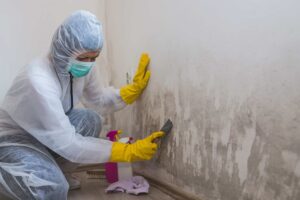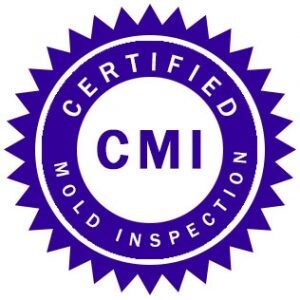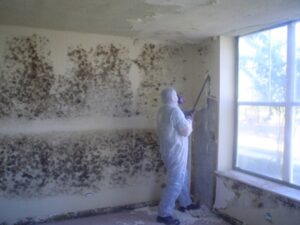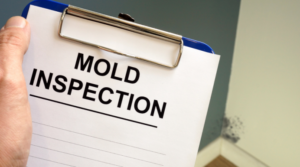Westchester Mold Testing Report

We at Certified Inspections are often asked what actions are needed if dangerous mold is found after we perform mold testing, also known as a mold assessment. The action is not a “one size fits all” one, but rather a custom made one that is specifically designed for the location and type of problem that was found. Below is a sample of a mold action plan, also known as a protocol that we would supply a client with. The client, in turn, would forward this protocol to a mold remediation company and they would have to base their proposal for the work done on this protocol.
Protocol for Mold Remediation
Date: 5/10/22
Client: John Doe
Address of Job: 27 Main St.
Overview: Swab surface testing performed by Certified Inspections, Inc. on 5/1/22 indicated the presence of high levels of mold in the air of all rooms in the basement as well as on the wall of the rec room, storage room doors and window sills in the baby’s room.
Areas Affected: Basement and baby’s room, however, all window sills should be treated since only the baby’s room window was sampled and similar particulate was observed on other windows in the house.
Cause of Problem: Seepage, ambient moisture, past plumbing leaks, past roof leaks and inadequate roof ventilation.
Cost Estimate: Typical remediations of this nature, not including any restoration expenses such as replacement of sheetrock and insulation or corrective measures such as waterproofing, ventilation or dehumidification are in the range of $5,000-$30,000, however an actual estimate which may be higher or lower than this range should be obtained from the remediation company.

General Safety Guidelines: A plastic sheet with a zipper door should be installed at the top of the basement stairs to create a containment area. Workers should wear appropriate full body protective clothing and masks with a greater than N-95 respirator. A negative vacuum should be created in the workspaces at all times with a HEPA vac that is vented to the outside. There should be four air exchanges per hour.
Treatment of All Basement Contents: All fabric and foam-containing items including sofas, upholstered chairs, pillows, luggage, tote bags, stuffed animals, the insulation in the boiler room, curtains and all paper and cardboard items should be discarded in sealed plastic bags. Rugs should be either discarded or HEPA vacuumed and steam cleaned. Clothes may be washed in hot water and detergent or dry-cleaned. All other objects, fixtures, furniture, contents, electronics, appliances, shelving, counters, etc. made of wood, plastic, metal, ceramic or glass may be HEPA vacuumed and hand-wiped with a mycocide such as Microban Plus. Items that have been stored in plastic bins or bags can have only the exterior of the bins or bags treated unless the contents were exposed to the air for any significant period of time. Paper items, books, documents and artwork that the occupants wish to save should be HEPA vacuumed then hand-wiped with a gentle mycocide. The client should let the remediation contractor know which items they wish to keep. The contents that are going to be saved should be placed in an outside pod or under plastic until the area is disinfected.

Window Sills: The window sills in all other rooms should be HEPA vacuumed and treated with a mycocide. Care should be taken on sills with peeling or chipped paint to not agitate the paint so it becomes airborne in the event that it contains an unsafe amount of lead.
Air scrubbers should run in all rooms that were remediated for approximately an additional two days after the remediation has been completed and kept running until we return to perform the clearance testing.
After at least 48 hours of air scrubbing and not longer than 2 or 3 more days, pursuant to NYS law, the work areas should be re-inspected by us – not the abatement company, and the air tested in a post-abatement clearance test to determine whether the mold levels have been reduced to an acceptable level. This must be done before any installation of insulation or sheetrock has been initiated.

The following work is not necessarily part of the abatement work, but is recommended to do so that the mold doesn’t return to the infected area or any other area of the building. It should be done as soon as the mold has been abated and re-tested. In summary, abatement is the process of cleaning up the mold only. The following is what to do to keep the mold from returning, which is done by various waterproofing contractors, roofers, carpenters, landscapers, engineers, plumbers and other qualified tradesmen:
If seepage is still occurring, a qualified waterproofing company that provides a lifetime or long term warranty should be contacted to inspect the basement. Alternatively, a civil engineer (PE) should be consulted to diagnose and develop a design to remedy the water infiltration problem.
Dehumidifiers that are properly sized for the volume of all rooms in the basement should be installed and run from spring through fall. The humidity level of the dehumidifiers should never be allowed to exceed 50% and should be monitored with hygrometers for the sake of accuracy. Many HVAC companies will measure your basement and install the properly fitted equipment.
The roof should have adequate ventilation so the house can breathe. Generally this entails a system of continuous soffit vents with a ridge vent. Vents should not be blocked by insulation. Ventilation can also be augmented with a mechanical venting system or other system designed by an engineer. An engineer (PE) should be consulted to design the appropriate roof ventilation system for this house so it can properly breathe. A qualified contractor can execute his plans.
Make sure gutters are cleaned, properly pitched, and discharge water away from the foundation.
The bathrooms should have a fan that is vented to the outside and always used while showering and left on until the humidity levels have been suitably reduced.
Have a qualified plumber inspect all plumbing for signs of immanent leaks.
*All drainage and construction work should be under the guidance & supervision of a licensed engineer.
*All abatement should be performed by a professional abatement company.
*Certified Inspections Inc., is a home inspection and environmental testing company only, and does not do abatement work or profess to have expert knowledge in the field of abatement or industrial hygiene. It is recommended that the client contact an industrial hygienist for detailed abatement plans, and the manufacturers of the products listed above for information pertaining to the safety and effectiveness and proper handling of those products. The methods and products listed above were suggested by 2 professional abatement companies we consulted with, and Certified Inspections Inc., makes no claims or warranties as to the effectiveness or safety of these materials, or of the consequences from the workmanship of the people hired to perform the work.
*The location of work areas is based upon the condition found at the time of inspection only. Mold can grow rapidly and the condition may have changed since that time
Please contact us if you have any questions.
Contact Information
Email: certified@optonline.net
Hotline: (914) 736-3165
Cell: (914) 414-2943
